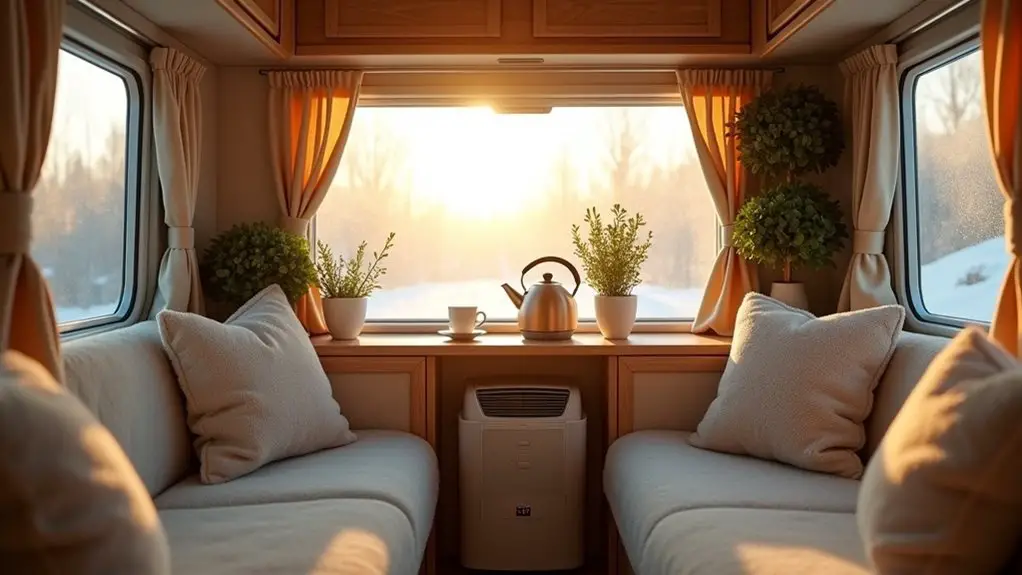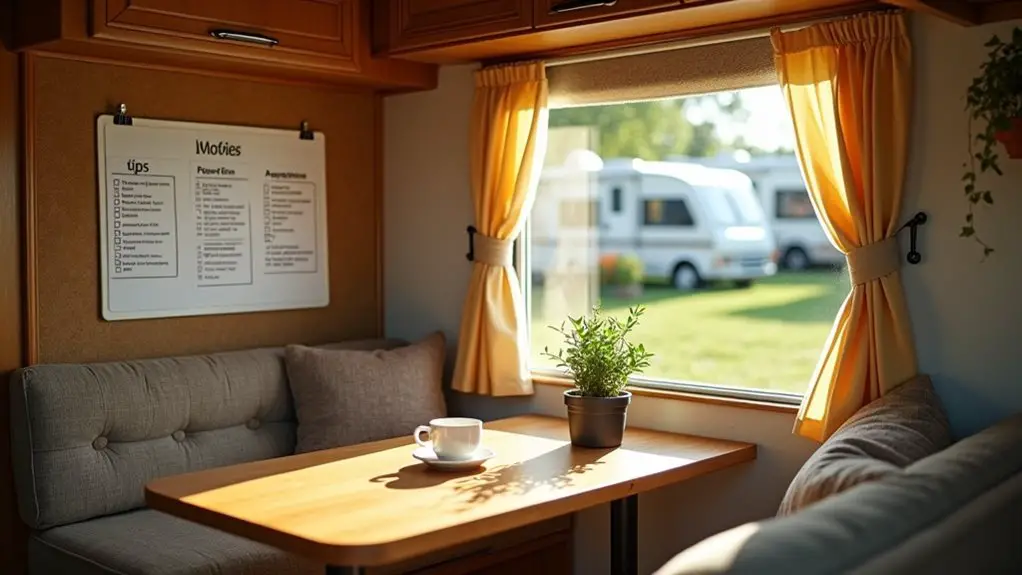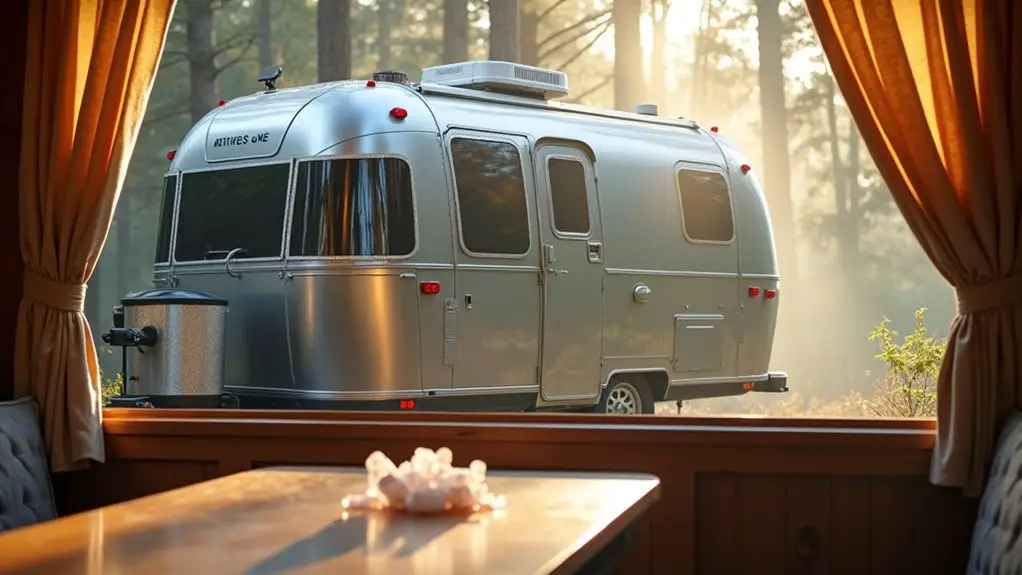So, you’re in your RV, enjoying the great outdoors, when bam—condensation slaps you in the face like a wet sponge. Yeah, it’s a total buzzkill. Look, moisture is your arch-nemesis, especially when it comes to that cozy space you thought you’d escape to. You can try opening windows or timing your cooking like a pro chef, but if you don’t level up with some innovative tricks, you might as well put a “wet floor” sign on your RV. Curious about what’s next?
Key Takeaways
- Install Low-E insulation to create a barrier against cold air and reduce condensation inside your RV.
- Utilize 12V fans for improved air circulation, helping to disperse moisture throughout the space.
- Employ soak ropes or damp-absorbing products to effectively absorb excess moisture from the air.
- Practice cooking and showering at times that minimize adding humidity to your RV environment.
- Keep windows cracked for ventilation and consider quilted window covers to retain warmth and reduce condensation.
Understanding the Causes of RV Condensation
All right, let’s get real about RV condensation. It’s like waking up in a damp sock—nobody wants that. You’ve got cold outside air crashing into your warmer, moister RV. It’s a recipe for trouble.
Every breath you take adds moisture, like when you’re packed in with your friends after chili night. Then there’s cooking, showering, or even just existing. You’re basically a humidity factory on wheels.
Plus, cold dreams of cozy winter nights come with foggy naps and soggy mattresses. You can’t escape it—understanding these causes is key.
Traditional Methods for Preventing Condensation
Now, if you’re hoping for a miracle cure to keep condensation at bay in your RV, let me break it to you: it’s not that simple.
You might crack a window, leave that ceiling vent open, and feel like a genius—until you realize you’re just inviting winter’s chill inside.
Sure, mopping up condensation with towels feels productive, but it’s like bailing water from a sinking ship.
You could invest in endless towels or fans, but honestly, how many can you fit in there?
Relying on these traditional methods is a slippery slope, and you might just end up in a damp situation.
Innovative Products for Moisture Control
When you’re stuck dealing with condensation in your RV, you quickly realize that traditional methods just don’t cut it. Cracking a window? Sure, if you enjoy shivering.
Enter innovative products like the soak rope—it drinks up moisture like it’s on a mission to save your dashboard. And thermal break tape? It’s a game changer for keeping condensation in check, especially in cabinets.
Plus, don’t underestimate the power of a good 12V fan for circulation. You want practicality that doesn’t squeeze your wallet hard.
Future Solutions for Reducing Winter Condensation

While you might be wishing for a miracle to handle winter condensation in your RV, the reality is a bit less magical and a lot more down-to-earth.
New products are on the horizon, like that Italian wonder promising to tackle condensation without needing a financial bailout.
Keep your eyes peeled for that Italian miracle to combat winter condensation—no loans required!
But hey, until then, you’re stuck with trial and error—think less “Eureka!” and more “Well, that didn’t work.”
Keep an eye out for your German alternative, too—just don’t expect a magic bullet.
If all else fails, consider a drive-in freezer. Who knew winter camping would turn into a DIY refrigeration project, right?
Effective Humidity Management Strategies
Look, getting a handle on humidity in your RV isn’t just some whimsical wish—it’s a matter of survival out there in the winter wild.
To fight the dampness, get creative. Using Low-E insulation’s a smart move; it’s like giving your RV a cozy winter coat.
Timing your cooking also helps—nobody wants a sauna when they’re trying to make breakfast. A 12V fan can circulate air, while window covers keep things warm.
And remember, driving with heat on? Yeah, it’s not just for comfort; it’s a sneaky way to dry things out.
Keep the moisture in check, and you’ll be golden!
Importance of Monitoring Dewpoint
What’s the point of monitoring the dewpoint? It’s simple: condensation hides everywhere, waiting to ruin your RV experience.
You don’t want a soggy mattress or moldy corners sneaking up on you. Keeping the temperature above the dewpoint is key. Miss that, and you’re asking for trouble.
Don’t let a soggy mattress or moldy corners ruin your trip—keep the temperature above the dewpoint!
Use sensors if you have to. They’re not just high-tech gadgets; they’re your moisture watchdogs. You wouldn’t let your dog off-leash in a busy street—so why let condensation run wild?
Plus, knowing the dewpoint helps you plan your ventilation strategy. It’s about staying dry and saving your sanity.
Now go on, monitor it!
Community Tips and Best Practices

Got your dewpoint game on lock? If not, you’re not alone. RVers everywhere are battling moisture like it’s a full-contact sport.
Here’s the deal: crank up that 12V fan and use those quilted window covers to keep the warmth inside. Got towels? Keep ’em handy—moisture gathering on surfaces doesn’t care about your trip agenda.
Community favorites like soak ropes? They’re a lifesaver, not just for your interior but for your sanity too.
Check your ventilation; cracked windows work, but less travel means less risk of fogging. Embrace the hustle—it’s all about keeping your ride cozy without the swamp vibes.
Staying Informed: Resources and Recommendations
When you tackle the RV lifestyle, you quickly realize that staying informed is half the battle against condensation chaos. You need hacker-level skills to manage that pesky moisture, so keep your ear to the ground.
Check community forums, subscribe to newsletters, and learn from fellow RVers. Here’s a quick guide to get you started:
| Resource | Purpose | Notes |
|---|---|---|
| RV Forums | Share tips and tricks | Lots of trial and error experience here |
| YouTube | Visual demonstrations | Great for visual learners, but don’t get sucked into a rabbit hole |
| Newsletters | Product reviews and updates | Stay ahead of trends and products |
| Blogs | In-depth articles | Personal stories keep it relatable |
| Webinars | Expert Q&A sessions | Get direct answers to burning questions |
Don’t ignore these gems!
Frequently Asked Questions
Can Condensation Damage My Rv’s Electrical Systems?
Yeah, condensation can mess with your RV’s electrical systems.
Water’s not a fan of wires, right? Moisture can lead to corrosion and short circuits. You’ve got wiring for your lights, refrigerator, and more that don’t appreciate a surprise shower.
So, keep your rig dry or face the consequences. A little investment in moisture management can save you from a costly trip to the repair shop.
Don’t say I didn’t warn you!
How Does Insulation Thickness Affect Condensation Rates?
Insulation thickness plays a huge role in condensation rates. Thicker insulation means less heat loss and keeps the inside warmer, which helps reduce moisture buildup.
Think of it like wearing a thicker winter coat; you stay warmer, and your breath doesn’t condense into a fog.
For example, going from an inch to three inches can cut condensation by a fair chunk.
Are There Natural Remedies for Controlling RV Humidity?
Yeah, you can use natural remedies for controlling RV humidity. Things like rock salt and charcoal bags work wonders; they suck up moisture like a sponge.
Got a few plants? They help too—just don’t overdo it unless you wanna play jungle explorer.
You could even leave the windows cracked a bit for ventilation, but that’s risky on chilly nights.
Look, you’re not gonna turn your RV into a desert, but every bit helps, right?
What Are the Signs of Hidden Condensation in RVS?
You’ll know you’ve got hidden condensation in your RV when those pesky moldy smells pop up, or you find mysterious damp spots on your walls and mattresses.
Check for fogged windows when you’re parked—yep, that’s moisture building up.
Don’t forget the “dead” areas, like under cabinets.
If your clothes feel a bit damp or your breathing seems heavier, congratulations! You’re dealing with uninvited condensation.
It’s sneaky, but you can outsmart it.
Can I Use a Dehumidifier While Driving My RV?
Sure, you can use a dehumidifier while driving your RV, but let’s be real—it’s not exactly practical.
Most dehumidifiers rely on AC power, unless you want to lug a heavy battery around.
Plus, if it’s just you and your pilfered Taco Bell cups in there, airflow’s gonna be your best bud.
Keep a window cracked or crank that fan up; trust me, you’ll feel less like a soggy sponge and more like a dry-roasted nut.
Summing Up
So, there you have it—tackling RV condensation doesn’t have to be rocket science. Mix some common sense with a few clever tools, and you’ll keep things dry while saving some cash. Use fans, soak ropes, and those fancy window covers; they actually work. And don’t forget to crack a window now and then. You want to enjoy your camper, not swim in it. Now, go forth, conquer that humidity, and enjoy the open road!

